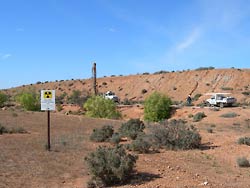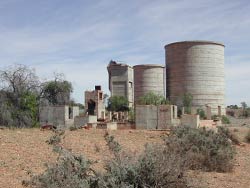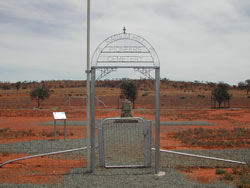Site management
The Resources and Energy Group has retained management responsibility of the site for the government, and maintains a continuing watch on the site with radiological advice and assistance from the Radiation Protection Division of the Environment Protection Authority.
Radiation and Environment Management Plan
In accordance with the condition of licence (Facilities Licence (LF3: Radioactive Substances Resulting from Past Practices), Radiation and Environment Management Plans (REMP) must be prepared and approved by the EPA and implemented for the sites. These plans were developed in 2016.
Site assessment
The remedial actions for Radium Hill will be based on a series of phases to identify site history, site characterisation, and risk to determine the optimal strategy for controlling the identified long term risks.
Yearly site activities
Monitoring will consist of:
- Visual inspection with photo reference points,
- erosion monitoring of Tails Storage Facility (TSF)/ waste rock,
- Groundwater dipping,
- Gamma measurements around TSF, and
- Checking of signage, road access.
- Groundwater monitoring: To determine what mechanisms and processes are occurring with respect to hydrogeological conditions at the site. Commenced 2006 and is an ongoing as part of REMP commitments (Bi-annual - monitoring well - level dipping and 5 yearly groundwater sampling).
- Gamma dose rates: The program will therefore include systematic routine gamma surveys to detect any long-term site changes (eg around and across the tailings impoundment), and particularly in the eastern half of the site and at identified elevated gamma dose rates.
- Routine visual inspections: Structural integrity, erosion points, fencing and warning signs should be regularly checked along with signs of unauthorised entry to the site.
- Annual license reports: The Annual Licence Report - Radiation and Environment Monitoring Report is a report required by EPA Licence LF4, (now 50986) under the Radiation Protection and Control Act 1982 (RP Act) and must be submitted annually.
- DPC (Nov 2017) radium Hill Uranium Mine & Low Level Radioactive Waste Repository - Annual Licence Report - Radiation & Environment Monitoring (work in progress)
Phase 1
Phase 1 was completed in 2004 and involved a preliminary investigation of the site.
More information about the management plan is available in Mcleary M 2004. Radium Hill Uranium Mine & Low-level Radioactive Waste Repository: Management Plan Phase 1 - Preliminary Investigation Report Book 2004/09 (PDF 9.2 MB)
Phase 2
Involved a more detailed site characterisation, which included;
Radon sampling - To determine radon emanation rates from the tailings impoundment, waste rock piles and other areas around the site. Completed 2004.
Waste quantification and site survey - To quantify all existing wastes, covers as well as mark all former mine openings etc. Completed 2005.
Remaining resource calculation - Assessment of the published reserve and resource calculations for the Radium Hill Mine. Completed 2005.
Preliminary hydrogeological investigation - Installation and sampling of water observation wells. Completed 2006 with ongoing monitoring.
Contaminated site survey - Contaminated Site Survey Identification and sampling of radiometric and other contaminant anomalies in line with the National Environment Protection (Assessment of Site Contamination) Measure 1999 NEPM). Completed 2006.
Detailed radiometric survey - Completed 2007.

Installing monitoring bores near tailings impoundments at Radium Hill (2006)

Remaining ore bins in Radium Hill mine area (2005)

Radium Hill pioneers cemetery
Phase 3
Covered the risk assessment and control selection for the site. Upon completion of the 3rd phase sufficient information should then be available to enable an effective and informed decision to be made on the future management of the site (Phase 4). Phase 3a - Risk assessment and control scoping was completed. 3b - control selection is yet to be complete.
Phase 3a - Risk assessment and control scoping
Introduction
The South Australian government's Mineral Resources Division (then part of PIRSA) engaged ENSR (now part of AECOM) Australia to perform a Contaminated Site Risk Assessment and Remediation Control Scoping Study as part of the Radium Hill Uranium Mine remediation project. The Mineral Resources Division manages the former Port Pirie site on behalf of the South Australian Government.
ENSR (now part of AECOM) is a leading global environmental consultancy with over 25 years experience in environmental risk assessment.
Between 2003 and 2010 the South Australian mine regulator (now DPc Mining Regulation) engaged AECOM consultants to undertake a detailed site characterisation, including human health and environmental risk assessments and options for ongoing management of the risks.
What is risk assessment
Risk assessment considers potential human health and ecological exposures and relevant radiological and chemical toxicities which might occur in a given environmental situation. An estimate using realistic but worst case assumptions of contact with the contaminants is made.
Background
Upon its closure in 1961, the Radium Hill mine was abandoned, access to mine workings were blocked and infrastructure was removed. Further rehabilitation included additional backfilling of old mine openings and covering of the tailings impoundment. At the same time, the site was also established as a repository for low-level radioactive waste materials.
The project
In 2009, a risk assessment and control scoping study (the Scoping Study) was conducted. The Scoping Study was prepared for the purpose of developing plans for managing the risks associated with these two sites.
The aim of the risk assessment and control scoping study is to estimate human and ecological risks associated with radiological and non-radiological contaminants within the terrestrial environment. Understanding the risks will enable potential options to be identified for the future and responsible decisions to be made regarding remedial action for Radium Hill.
Radiation and Environmental Risks
The Human Health Radiological Risk Assessment studies found that under the existing scenarios (current station works, hypothetical trespasser or site visitor) if they didn't spend more that 5-10% of their time at the designated 'hot spot', it is unlikely radiation doses will exceed the dose limit of 1mSv in a year for members of the public set by the Australian Radiation Protection and Nuclear Safety Agency (ARPANSA).
Please download the EPA fact sheet Naturally occurring radioactive material (NORM) for further information.
Whilst short to medium term risks identified in the Scoping Study have been addressed in the REMPs, further studies will be required to determine the optimal strategy for controlling the identified long term risks. The short to medium term risks are focused on the Human Health Chemical (Non-Radiological) risks, Human Health Radiological Risks, Ecological Risk Assessment and technical risk eg geotechnical, hydrological etc.
Radium Hill risk issues and uncertainties identified are related potential for contaminants to mobilise from the tailings waste dump due to structural failure, erosion or seepage. The potential for reduced tailings dump stability would be exacerbated through an increase in soil moisture content and overtopping through an increase in rainfall and storm events that are predicted as the potential effects of climate change. The potential for failure of the capping over the underground workings represents a public safety risk on this site. This is currently rated a low risk due to the remoteness of the site. However, this risk may increase if the level of tourism in the area increases.
Reports include:
- AECOM; July 2009; Contaminated site risk assessment, conceptual site model and workplan Former Radium Hill Uranium Mine and Low-level Radioactive Waste Repository;
- AECOM; July 2009; Human Health Risk Assessment (Chemical Non-Radiological), Radium Hill Uranium Mine, Radium Hill, South Australia;
- AECOM; August 2009; Human Health Radiological Risk Assessment, Radium Hill Uranium Mine, Radium Hill, South Australia;
- AECOM; November 2009; Ecological Risk Assessment, Radium Hill Uranium Mine, Radium Hill, South Australia;
- AECOM; May 2010; Remediation Control scoping, Radium Hill Uranium Mine, Radium Hill, South Australia;
- DPC (Nov 2017) Radium Hill Uranium Mine & Low Level Radioactive Waste Repository- - Annual Licence Report - Radiation & Environment Monitoring (This report is still in progress)
Combined reports
- AECOM; July 2009; Contaminated site risk assessment dta review and gap identification - Port Pirie rare earth treatment plant and former radium hill uranium mine
- AECOM; May 2010; Port Pirie/Radium Hill Risk Assessment - A hydrological data review and scoping study
- AECOM; August 2010; Climate change review and assessment - Port Pirie/radium Hill Uranium Mine
- AECOM; August 2010; Geotechnical Assessment - Port Pirie/Radium Hill Uranium Mine
Phase 3b - control selection
3b - Control selection will involve further studies to determine the optimal strategy for controlling the identified long term risks.
Phase 4
The final phase will see the development and implementation of an appropriate long-term management plan for the site. As part of this strategy there is a need to inform and consult with various stakeholders in order to implement an outcome for the present and ongoing management of the site.
Useful download
Radium Hill Risk Assessment and Remediation Scoping Project (PDF, 140.0 KB)


